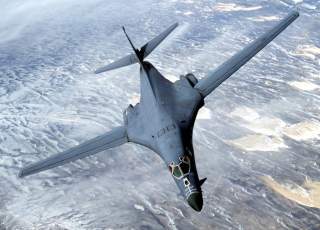Bad News: Not All of America's B-1 Bombers Are Ready for War
In fact, only 7 are fully "mission capable."
Key point: B-1 bombers are important and it is vital to have all of them ready for any contingency.
Just seven of the U.S. Air Force’s 61 B-1 bombers are fully mission-capable, South Dakota senator Mike Rounds revealed on July 30, 2019.
The B-1 shortfall could weigh on the Air Force’s plans for a new bomber.
Fifteen of the swing-wing B-1s are in depots for maintenance. Thirty-nine aircraft are down for inspections, Rounds said during a Senate Armed Services Committee confirmation hearing for Air Force general John Hyten.
Hyten is Pres. Donald Trump’s nominee to become vice chairman of the Joint Chiefs of Staff. His candidacy is imperiled by a serious accusation of sexual assault.
Ellsworth Air Force Base in South Dakota houses two B-1 squadrons. Others are based in Texas and California. B-1s for many years flew from bases in the Middle East for long-endurance close-air-support missions over Iraq and Afghanistan.
Round-the-clock operations took a toll on the 1980s-vintage warplanes. The Air Force twice in 2018 and 2019 grounded the B-1 fleet following mechanical failures.
“We were just beating the heck out of them, deploying them, deploying them,” Hyten said of the B-1s in response to Rounds’ comment. “We had to pull back a little and get after fixing those issues. The depots can do that if they have stable funding.”
A dearth of flyable B-1s has compelled the Air Force to transfer aircrew to other types, according to Air Force magazine reporter Rachel Cohen, citing a Senate subcommittee report.
“The committee is concerned B-1 readiness does not have the priority and resources to improve B-1 mission-capable rates,” the report states, according to Cohen. “This is evidenced by fully mission-capable aircraft currently in single digits and aircrew being rerouted from flying the B-1 to other aircraft due to lack of B-1 aircraft for training.”
The Air Force plans to replace the B-1s as well as 20 radar-evading B-2s with a new stealth bomber, the B-21. The service still is mulling how many B-21s to buy. “We’re exploring the force structure between the B-1, the B-2 and the B-52,” Air Force vice chief of staff Gen. Stephen Wilson said at an event in Washington, D.C. on July 24, 2019.
The Air Force repeatedly has said that, in the 2030s, it will retire its 61 1980s-vintage B-1 bombers and, a few years later, also will retire all 20 '90s-vintage B-2 stealth bombers.
Meanwhile, the service would upgrade 76 B-52s that first flew in the early 1960s and buy at least 100 new B-21 stealth bombers. The result in the 2040s would be a force of around 175 bombers composed of factory-fresh B-21s and 80-year-old B-52s.
"That plan has not changed," Heather Wilson, the former service secretary, said in February 2019. "We need a minimum of 175 bombers, is what we announced last year,” Wilson added, "and that they will be a mix of B-21s and B-52s."
Heather Wilson's announcement raises a multi-billion-dollar question. How does the Air Force plan to equip the five new bomber squadrons the service said it needed as part of its September 2018 plan to grow from 312 squadrons to 386?
In early 2019 the Air Force maintained nine front-line bomber squadrons at bases in Missouri, Texas and North and South Dakota. A bomber squadron typically has eight aircraft. The balance of the bomber fleet belongs to training units or is undergoing deep maintenance.
Adding five new squadrons could compel the Air Force to acquire around 75 extra bombers in addition to the 100 it committed to buying when, in 2015, it awarded Northrop Grumman the B-21 development contract.
And the B-1’s readiness woes could force the Air Force to buy the B-21s more quickly, as the older swing-wing bombers might not last into the 2030s. “The general consensus is, we don’t have enough long-range strike capacity,” Stephen Wilson said.
Wilson told the Washington, D.C. audience he in recent weeks visited Northrop Grumman’s facilities in Melbourne, Florida, where he was “looking at the B-21.”
Northrop is “moving out on that pretty fast.” Wilson said, adding he has an app on his phone “counting down the days … and don’t hold me to it, but it’s something like 863 days to first flight.”
That would place the B-21’s first flight in December 2021.
David Axe serves as Defense Editor of the National Interest. He is the author of the graphic novels War Fix, War Is Boring and Machete Squad. This first appeared in July 2019.
Image: Wikimedia

